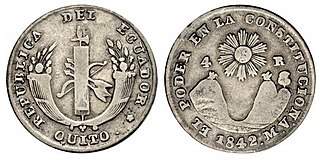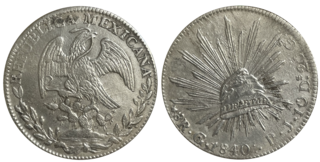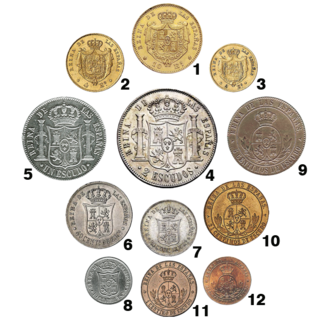
The real was the currency of Colombia until 1837. No subdivisions of the real existed until after the real had ceased to be the primary unit of currency. However, 8 reales = 1 peso and 16 reales = 1 escudo.

The real was the currency of Colombia until 1837. No subdivisions of the real existed until after the real had ceased to be the primary unit of currency. However, 8 reales = 1 peso and 16 reales = 1 escudo.
Until 1820, Colombia used the Spanish colonial real, some of which were minted in Bogotá and Popayán. [1] After 1820, issues were made specifically for Colombia, under the various names that the state used. In 1837, the peso, worth 8 reales, became the primary unit of currency. The real continued to circulate as an eighth of a peso until 1847, when a new real was introduced worth one tenth of a peso and subdivided into 10 decimos de real. This new real was renamed the decimo in 1853, although coins denominated in reales were again issued 1859-1862 and in 1880.
During the Spanish colonial period, silver 1⁄4, 1⁄2, 1, 2, 4 and 8 reales and gold 1, 2, 4 and 8 escudos were struck at Bogotá and Popayán, the last of which were produced in 1820. During the war of independence, regional issues were made by royalists in Popayán and Santa Marta, and by republicans in Cartagena and Cundinamarca. Popayán issued copper 1⁄2, 2 and 8 real coins, Santa Marta issued copper 1⁄4 and 1⁄2 real and silver 2 reales, Cartagena issued copper 1⁄2 and 2 reales, and Cundinamarca issued silver 1⁄4, 1⁄2, 1 and 2 reales. Cundinamarca went on to issue silver 1⁄2, 1, 2 and 8 reales between 1820 and 1823.
The United Provinces of New Granada issued silver coins in denominations of 1⁄2, 1, 2 and 8 reales between 1819 and 1822. These were followed by coins of the Republic of Colombia, silver 1⁄4, 1⁄2, 1 and 8 reales, and gold 1 peso, 1, 2, 4 and 8 escudos.
Around 1819, notes were issued by the government in denominations of 1⁄2, 1, 2 and 4 reales, also denominated as 6+1⁄4, 12+1⁄2, 25 and 50 centavos. These were followed, some time in the 1820s, by notes for 1, 2, 3 and 5 pesos.
The peso is the currency of Chile. The current peso has circulated since 1975, with a previous version circulating between 1817 and 1960. Its symbol is defined as a letter S with either one or two vertical bars superimposed prefixing the amount, $ or ; the single-bar symbol, available in most modern text systems, is almost always used. Both of these symbols are used by many currencies, most notably the United States dollar, and may be ambiguous without clarification, such as CLP$ or US$. The ISO 4217 code for the present peso is CLP. It was divided into 100 centavos until 31 May 1996, when the subdivision was formally eliminated. In February 2023, the exchange rate was around CLP$800 to US$1.
The Colombian peso is the currency of Colombia. Its ISO 4217 code is COP. The official peso symbol is $, with Col$. also being used to distinguish it from other peso- and dollar-denominated currencies.

The rupia was the currency of Portuguese India sometime after 1668 until 1958. Prior to 1668, the currency unit was Xerafim. In 1666, the Portuguese administration struck a silver coin calling it double xerafin and this was declared equal to a rupia in circulation in India outside of Portuguese possessions. A xerafim was a convertible subunit of rupia, and it was unique to Portuguese colonies in India. One rupia equalled two xerafims.

The real was a unit of currency in Spain for several centuries after the mid-14th century. It underwent several changes in value relative to other units throughout its lifetime until it was replaced by the peseta in 1868. The most common denomination for the currency was the silver eight-realSpanish dollar or peso which was used throughout Europe, America and Asia during the height of the Spanish Empire.

The real was the unit of currency of Portugal and the Portuguese Empire from around 1430 until 1911. It replaced the dinheiro at the rate of 1 real = 840 dinheiros and was itself replaced by the escudo at a rate of 1 escudo = 1000 réis. The escudo was further replaced by the euro at a rate of 1 euro = 200.482 escudos in 2002.

The piastre de commerce was the currency of French Indochina between 1885 and 1954. It was subdivided into 100 cents, each of 2~6 sapèques.

The real was the currency of Portuguese Angola until 1914. It was equal to the Portuguese real. No subdivisions existed, but some coins were issued denominated in macutas, worth 50 réis. The real was replaced by the escudo in 1914.
The real was the currency of Argentina until 1881. From 1822, it was subdivided into 10 décimos. The sol was also issued during this period and was equal to the real, whilst the peso was worth 8 reales and the escudo was worth 16 reales.

The silver real was the currency of the Spanish colonies in America and the Philippines. In the seventeenth century the silver real was established at two billon reals or sixty-eight maravedís. Gold escudos were also issued. The coins circulated throughout Spain's colonies and beyond, with the eight-real piece, known in English as the Spanish dollar, becoming an international standard and spawning, among other currencies, the United States dollar. A reform in 1737 set the silver real at two and half billon reals or eighty-five maravedís. This coin, called the real de plata fuerte, became the new standard, issued as coins until the early 19th century. The gold escudo was worth 16 reales de plata fuerte.
The peso was the currency of El Salvador between 1877 and 1919.

The real was the currency of Ecuador until 1871. There were no subdivisions but 16 silver reales equalled 1 gold escudo, with the 8 reales coin known as a peso.

The real was a currency of Mexico, issued until 1897. There were 16 silver reales to 1 gold escudo, with 8 tlacos to the real. The peso, which circulated alongside the real and eventually replaced it, was equal to 8 reales.

The real was the currency of Peru until 1863. Sixteen silver reales equalled one gold escudo. The silver coin of 8 reales was also known as the peso.

The escudo was either of two distinct Spanish currency denominations.
The real was the currency of Costa Rica until 1850 and continued to circulate until 1864. It had no subdivisions. 16 silver reales equaled 1 gold escudo. The real was replaced by the peso at a rate of 1 peso = 8 reales.
The Philippine real was the currency of the Philippines during the Spanish Colonial Era. Brought over in large quantities by the Manila galleons, eight silver reales made up a silver peso or a dollar. 16 silver real were equal to one gold escudo.
The real was the currency of Venezuela until 1843.

This article provides an outline of the currency of Spanish America from Spanish colonization in the 15th century until Spanish American independencies in the 19th. This great realm was divided into the Viceroyalty of New Spain, which came to include all Spanish territory north of Panama, the West Indies, Venezuela, and the Philippines, and the Viceroyalty of Peru, which included Panama and all Spanish territory in South America except Venezuela. The monetary system of Spanish America, originally identical to that of Spain, soon diverged and took on a distinctive character of its own, which it passed on to the independent nations that followed after.
Currency in Colombia denotes the ingots, coins, and banknotes that have been used in Colombia since 1622. It was in that year, under a licence purchased from King Philip III of Spain, that Alonso Turrillo de Yebra established a mint at Santa Fe de Bogotá and a branch mint at Cartagena de las Indias, where gold cobs were produced as part of Colombia's first currency. Silver milled coins date from 1627. In 1831, Gran Colombia dissolved into Venezuela and New Granada. In 1836, in New Granada, new monetary laws were passed, to standardise the money produced in the country. From 1861 to 1862, due to financial instability, the United States of New Granada accepted British currency, the name of the country becoming the United States of Colombia in 1862. In 1880, Colombia pegged the peso to the gold standard due to the falling price of silver. In 1886, the paper peso was introduced. In 1931, Colombia abandoned the gold standard and switched to the current form of the peso.
This article provides a historical summary of the currency used in Ecuador. The present currency of Ecuador is the United States dollar.